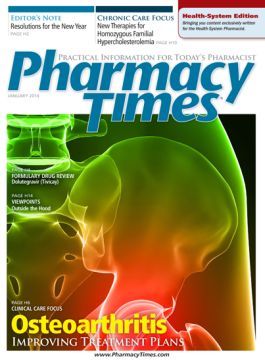Outside the Hood


While the safety of compounded sterile preparations (CSPs) has been an important topic in the practice of pharmacy for decades, the recent tragic deaths related to fungal contamination of preservative-free methylprednisolone injection have once again put the topic on the national stage. In light of this call to ensure patient safety, hospital pharmacies have been evaluating their use of outsourcing and their own compliance with United States Pharmacopeial Convention (USP) chapter <797> regulations.1
Microbial contamination of CSPs can occur in any practice setting and puts patients at risk of significant morbidity and mortality. It is important to note that some CSPs are prepared and administered in clinics, at the bedside, in procedural areas, and in operating rooms with little direct pharmacy oversight. While quality and safety programs exist within other health care professions, pharmacy knowledge and involvement in these activities ensures compliance with best practices and also provides an opportunity for pharmacy to take ownership of the complete medication use process.
The publication of the USP <797> in 2004 represents the first official enforceable standard for sterile compounding in the United States. Prior to its publication, there was little monetary or official support for pharmacies looking to improve their compounding processes, despite thousands of cases of septicemia from exposure to compounded intravenous (IV) from the 1970s on.2 The incorporation of USP <797> into state legislation and adoption of a policy of enforcement by the Joint Commission encouraged swift action and compliance on the part of hospitals and pharmacies across the country. The chapter stratifies the compounding of all sterile products, including irrigations and ophthalmic preparations, into 3 risk levels based on the sterility of the bulk ingredients and the degree of manipulation required to make the final product. The risk levels and requirements for each are summarized in Online Table 1.
Table 1: USP <797> Risk Levels
Type of Compounding
Definition
Requirements
Beyond use dating:
Room Temperature
Refrigerated
Low-risk
· Simple admixtures compounded using closed system transfer
· Prepared in ISO Class 5
· Located in ISO Class 7 buffer area with ISO class 8 ante area
48 hours
14 days
Low-risk with <12 hour BUD
· Simple admixtures compounded using closed system transfer
· Prepared in ISO Class 5
· Compounding area is separated from non-compounding area
12 hours
12 hours
Medium-risk
· Multiple additives and/or small volumes
· Batch preparations
· Preparation for use over several days
· Complex manipulations (ie, TPN)
· Prepared in ISO Class 5
· Located in ISO Class 7 buffer area with ISO class 8 ante area
30 hours
9 days
High-risk
· Non-sterile ingredients
· Open system transfers
· Prepared in ISO Class 5
· Located in ISO Class 7 buffer area with separate ISO Class 8 ante area
24 hours
3 days
Immediate-use
· Emergent use
· Situations where low-risk compounding would delay therapy and add risk
· Low-risk preparations only
· No storage or batch compounding
· Aseptic technique utilized
1 hour
1 hour
BUD = beyond use date; ISO = International Organization for Standardization; TPN = total parenteral nutrition.
Revisions to the chapter in 2008 defined an immediate-use category that is notably exempt from preparation in an International Organization for Standardization Class 5 environment, and therefore may be compounded more generally outside the pharmacy area. This exemption was employed to address emergent situations where the use of low-risk compounding practices would delay drug administration to the patient (ie, cardiopulmonary resuscitation, emergency department, or preparation of diagnostic agents). Only low-risk compounding may occur under these circumstances, and the product must be administered within 1 hour. A pharmacist is not required to verify the sterility, stability, or accuracy of the final product.
Risk of Microbial Contamination
While the benefit of bedside preparation of agents clearly outweighs the risk in certain situations, there appears to be a greater risk of microbial contamination in syringes prepared in patient care areas. A study evaluating the incidence of microbial contamination of CSPs evaluated 3 testing environments: an ISO class 5 horizontal laminar-airflow hood in an ISO class 6 cleanroom, an ISO class 7 drug preparation area in an operating room, and an uncontrolled decentralized pharmacy on a ward. The authors compared 4 common compounding manipulations and identified overall contamination rates of 0%, 6%, and 16% after 14 days for syringes prepared in the cleanroom, operating room, and ward respectively.3
Additionally, a systematic review sought to compare contamination rates when doses were prepared in controlled (pharmaceutical) and ward environments, and when prepared as an individual dose versus part of a batch preparation. The authors reviewed 19 studies representing 7277 doses and found overall contamination rates in individual versus batched doses of 5.0% and 2.0% in ward environments, and 1.9% and 0.0% in pharmaceutical environments. The authors concluded that contamination risk still exists in both environments, but appears to be higher in ward environments and when doses are prepared individually rather than as part of a batch procedure.4
Microbial contamination in the intraoperative5 and intensive care unit6 environments have been similarly documented. Given this established risk of contamination, as well as the absence of quality assurance measures to address compatibility and stability, it is imperative that pharmacy departments describe and utilize practices to minimize immediate-use compounding when possible.
Prior to the enforcement of the USP <797> standard, diverse practices with regard to immediate-use compounding developed at the institutional and professional level. Health care practitioners, including nurses and physicians, gained experience compounding products in patient areas without a strong pharmacy presence. Despite the 9-year tenure of USP <797> guidance and the presence of other guidelines aimed at improving safety and quality of injectable medications,7,8 some of these practices persist as a result of their past success, convenience, and the comfort level of health care personnel.
As owners of the medication use process, pharmacists should continue to work with their colleagues in other professions involved in the preparation and administration of sterile products to ensure that immediate-use practices are not only compliant with the national standard, but also that they are accurate, cost-effective, and safe for the specific patient population in question.
Best practice is using pharmacy services when possible to minimize immediate-use compounding. The use of a central pharmacy offers a number of advantages over immediate-use compounding in a patient area. The central pharmacy has quality assurance checks, including pharmacist verification of indication, dose, and patient-specific parameters to ensure safety prior to administration as well as verification of sterility and stability of the products dispensed. Practices that increase pharmacy presence in patient care areas and decrease time to administration of medications compounded in the pharmacy decrease the need for immediate-use compounding. Thus, access to pharmacy services 24 hours a day, 7 days a week is essential to providing safe, high-quality patient care. Additionally, ready-to-use products, which can be quickly transported to the bedside or stocked in an automated dispensing cabinet (ADC), can minimize the time to administration, thereby giving staff timely access to products in emergent situations.
Despite the lack of direct oversight of areas that carry out immediate use compounding, pharmacy departments can increase their contribution to ensure that best practices are met by addressing a variety of requirements. In 2007, the Centers for Disease Control and Prevention published a guideline for preventing transmission of infectious agents in the health care setting. This guideline identified areas of injection practice that posed the greatest risk for infection transmission. The recommendations are listed in Online Table 2 and focus mainly on preventing the reuse of syringes/cannulas/needles and the primary use of single-dose and single-patient vials.
Table 2: CDC Recommendations for Safe Medication Preparation and Administration
Safe Injection Practices: Recommendations from the 2007 CDC Guideline for Isolation Precautions: Preventing Transmission of Infectious Agents in Healthcare Settings
· Use aseptic technique to avoid contamination of sterile injection equipment.
· Do not administer medications from a syringe to multiple patients, even if the needle or cannula on the syringe is changed. Needles, cannulae, and syringes are sterile, single-use items; they should not be reused for another patient nor to access a medication or solution that might be used for a subsequent patient.
· Use fluid infusion and administration sets (ie, intravenous bags, tubing, and connectors) for 1 patient only and dispose appropriately after use. Consider a syringe or needle/cannula contaminated once it has been used to enter or connect to a patient’s intravenous infusion bag or administration set.
· Use single-dose vials for parenteral medications whenever possible.
· Do not administer medications from single-dose vials or ampules to multiple patients or combine leftover contents for later use.
· If multi-dose vials must be used, both the needle or cannula and syringe used to access the multi-dose vial must be sterile.
· Do not keep multi-dose vials in the immediate patient treatment area and store in accordance with the manufacturer's recommendations; discard if sterility is compromised or questionable.
· Do not use bags or bottles of intravenous solution as a common source of supply for multiple patients.
· Infection control practices for special lumbar puncture procedures: wear a surgical mask when placing a catheter or injecting material into the spinal canal or subdural space (ie, during myelograms, lumbar puncture, and spinal or epidural anesthesia).
· Worker safety: adhere to federal and state requirements for protection of health care personnel from exposure to blood-borne pathogens.
Adverse Events
Specifically, the reuse of single-dose vials (SDVs) for multiple patients has been linked to a number of adverse events.9 A 2010 survey of 5446 clinicians who prepared and/or administered parenteral medications found that 318 H16 (6.0%) respondents used SDVs on more than 1 patient in various circumstances.10 Pharmacy can encourage the practice of using 1 vial for 1 patient by limiting stock to vials containing volumes/ amounts of drug that are consistent with 1-time, single patient use. This is especially important with the increasing use of ADCs, whereby multiple vial sizes could be provided to minimize the amount of manipulation and waste on the part of the provider administering medications.
When being accessed in patient care areas, the use of multi-dose vials (MDVs) is less preferred given the temptation to utilize the contents in different patients, the need to track the beyond use date (BUD), and the possibility of greater amounts of waste given the size of the vial. Additionally, storage of MDV that has been accessed previously in a patient care area increases the risk of microbial contamination. While the recommended BUD for an MDV is 28 days, there is controversy if this dating applies equally to all environments (ie, clean room vs patient care area).
Pharmacy involvement in ensuring safety in this area again begins in the procurement phase of the medication use process, through minimizing the supply of an MDV if an SDV is available and cost-effective. Additionally, MDVs with volumes representative of the doses required for a single patient minimize the waste associated with their use in patient care areas. Provision of BUD labels in a convenient location (ideally near the medication) or dating by the pharmacy upon dispensing can also encourage compliance with labeling requirements.
Challenges
Ensuring appropriate beyond use dating and stability of products compounded outside of the pharmacy poses a number of challenges. Notably, the evidence behind the requirements stipulated in USP <797> has been challenged given the paucity of data supporting a 1-hour expiration of products compounded under these conditions.11 A study that evaluated sterility and stability of medications commonly used in obstetric anesthesia found no loss in drug concentration or sterility after storing syringes for 30 days at room temperature without protection from light. The authors of the study point out that multiple medical personnel were used to draw up syringes, with varying levels of adherence to aseptic technique.12 While compliance with 1-hour BUD is cumbersome and often requires drawing up syringes for individual cases, pharmacy batching of frequently used doses may be employed to ensure a longer BUD.
Ensuring proper BUD is especially important when IV infusions are compounded in patient areas, as they may be left hanging for an extended period of time in the absence of a procedure to obtain a product from the pharmacy with an increased BUD. Similarly, compatibility of additives with large-volume infusions may not be evaluated and ensured in the setting of immediate-use compounding. Pharmacy is uniquely equipped with drug-specific knowledge and quality assurance checkpoints to verify that an infusion is in the proper fluid, container, and concentration to ensure stability.
Conclusion
In summary, although the use of pharmacy services represents the ideal scenario for compounding sterile products, preparation of CSPs may be necessary in emergent situations and is described in USP <797> and other current guidelines. Given the risk of microbial contamination and fewer quality assurance checkpoints in the process of immediate-use compounding, efforts to provide 24/7 pharmacy services and improve time to administration should continue to be emphasized in hospital and health system pharmacies.
Pharmacists should serve as champions to educate staff on proper utilization of immediate-use compounding, including the use of single- and multi-dose vials in patient care areas. Pharmacist involvement in discussions of medication use in procedural areas and outpatient clinics is imperative to ensure open lines of communication so that potential problems can be addressed and averted. Pharmacists can also actively identify places where immediate-use compounding is being used inappropriately or where its use could be minimized.
Amber E. Proctor, PharmD, is a PGY1 pharmacy practice resident at the University of North Carolina Medical Center. Erinn C. Rowe, PharmD, MS, is a clinical manager at the University of North Carolina Medical Center and adjunct faculty at the UNC Eshelman School of Pharmacy.
References:
- Myers CE. History of sterile compounding in U.S. hospitals: learning from the tragic lessons of the past. Am J Health Syst Pharm. 2013;70(16):1414-1427.
- Buchanan EC, Cassano AT. The ASHP discussion guide on USP chapter <797>. www.ashp.org/s_ashp/docs/files/discguide797-2008.pdf.
- Stucki C, Sautter AM, Favet J, Bonnabry P. Microbial contamination of syringes during preparation: the direct influence of environmental cleanliness and risk manipulations on end-product quality. Am J Health Syst Pharm. 2009;66:2032-2036.
- Austin P, Elia M. A systematic review and meta-analysis of the risk of microbial contamination of aseptically prepared doses in different environments. J Pharm Pharmaceut Sci. 2009;12(2):233-242.
- Loftus RW, Koff MD, Burchman CC, et al. Transmission of pathogenic bacterial organisms in the anesthesia work area. Anesthesiology. 2008;109:399-407.
- Van Grafhorst JP, Foundraine NA, Nooteboom F, et al. Unexpected high risk of contamination with staphylococci species attributable to standard preparation of syringes for continuous intravenous drug administration in a simulation model in intensive care units. Crit Care Med. 2002;30(4):833-836.
- Dolan SA, Felizardo G, Barnes S, et al. APIC position paper: safe injection, infusion, and medication vial practices in health care. Am J Infect Control. 2010;38(3):167-172.
- Association of peri Operative Registered Nurses. Recommended practices for sterile technique. In: Perioperative Standards and Recommended Practices. Denver, CO: Association of periOperative Registered Nurses; December 2012:e62-e90.
- Siegel JD, Rhinehart E, Jackson M, Chiarello L; Healthcare Infection Control Practices Advisory Committee. 2007 Guideline for Isolation Precautions: Preventing Transmission of Infectious Agents in Healthcare Settings. www.cdc.gov/hicpac/pdf/isolation/isolation2007.pdf.
- Pugliese G, Gosnell C, Bartley JM, Robinson S. Injection practices among clinicians in United States health care settings. Am J Infect Control. 2010;38:789-798.
- Jansky K. Letter in response to APIC position paper: safe injection, infusion, and medication vial practices in health care. Am J Infect Control. 2010;38(8):664-665.
- Wagner, DS, Naughton NN, Pierson C, Michel T. Potency and sterility of anesthetic drugs in obstetric anesthesia. Int J Obstet Anesth. 2002;11(4):252-254.

